Blue Angels
- For the 1960 syndicated television series, see The Blue Angels (TV series)
| Blue Angels United States Navy Flight Exhibition Team | |
|---|---|
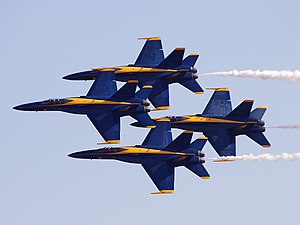 The Blue Angels F/A-18 Hornets fly in tight diamond formation maintaining 18" wing tip to canopy separation. | |
| Active | April 24, 1946 to Present |
| Country | |
| Branch | |
| Role | Aerobatic flight demonstration team |
| Size | 16 officers, 110 enlisted |
| Garrison/HQ | NAS Pensacola NAF El Centro (Winter Airfield) |
| Colors | "Blue Angel" blue "Insignia" yellow |
| Insignia | |
| Identification symbol |  |
| Aircraft flown | |
| Fighter | 10 - F/A-18A Hornets (single seat) 2 - F/A-18B Hornets (two seat) *Note - four aircraft are spares |
| Transport | 1 - C-130T Hercules |
The United States Navy's Navy Flight Demonstration Squadron, popularly known as the Blue Angels, first performed in 1946[1] and is currently the oldest flying aerobatic team. The squadron's six demonstration pilots fly the Boeing F/A-18 Hornet in more than 70 shows at 34 locations throughout the United States each year, where they still employ many of the same practices and techniques used in their aerial displays in 1946. Since their inception, the "Blues" have flown a variety of different aircraft types for more than 427 million spectators worldwide.
Mission
The mission of the Blue Angels is to enhance Navy recruiting, and credibly represent Navy and Marine Corps aviation to the United States and its Armed Forces to America and other countries as international ambassadors of good will.
Air show overview
The Blue Angels show season runs each year from March until November. They perform at military and civilian airfields, and often perform directly over major cities such as San Francisco and Seattle during "Fleet Week" maritime festivals.
During the aerobatic demonstration, the Blue Angels operate six FA-18 Hornet aircraft, split into the Diamond (Blue Angels 1 through 4) and the Lead and Opposing Solos (Blue Angels 5 and 6). Most of the show alternates between maneuvers performed by the Diamond and those performed by the Solos. The Diamond, in tight formation and usually at lower speeds, performs maneuvers such as formation loops, barrel rolls, and transitions from one formation to another. The Solos fly many of their maneuvers just under the speed of sound, showcasing the high performance capabilities of their individual Hornets through the execution of high-speed passes, slow passes, fast rolls, slow rolls, and very tight turns. Some of the maneuvers include both solo F/A-18s performing at once, such as opposing passes (toward each other in what appears to be a collision course) and mirror formations (back-to-back. belly-to-belly, or wingtip-to-wingtip, with one jet flying inverted). The Solos join the Diamond near the end of the show for a number of maneuvers in the Delta formation.
The parameters of each show must be tailored to local weather: in clear weather the "high" show is performed; in overcast conditions a "low" show is performed, and in limited visibility (weather permitting) the "flat" show is presented. The "high" show requires an 8,000-foot (2,400 m) ceiling and visibility of 3 nautical miles (6 km) from the show's centerpoint. "Low" and "flat" ceilings are 3,500 and 1,500 feet (460 m) respectively.
Squadron nickname, insignia and paint scheme
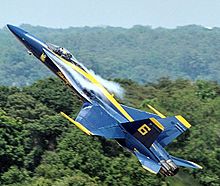
When initially formed, the unit was called the Navy Flight Exhibition Team. The squadron was officially redesignated as the United States Navy Flight Demonstration Squadron in December 1974. The original team adopted the nickname Blue Angels in 1946, when one of them came across the name of New York City's Blue Angel nightclub in the New Yorker Magazine. The team introduced themselves as the "Blue Angels" to the public for the first time on July 21, 1946 in Omaha, Nebraska.
The official Blue Angels insignia was designed by then team leader Lt. Cmdr. R.E. "Dusty" Rhodes and approved by CNO in 1949. It is nearly identical to the current design. In the cloud in the upper right quadrant, the aircraft were originally shown heading down and to the right. Over the years, the plane silhouettes have changed along with the squadron's aircraft. Additionally, the lower left quadrant, which contains the Chief of Naval Air Training insignia, has occasionally contained only Naval Aviator wings.
Originally, demonstration aircraft were navy blue (nearly black) with gold lettering. The current shades of blue and yellow were adopted when the team transitioned to the Bearcat in 1946. For a single year in 1949, the team performed in a blinding all-yellow scheme with blue markings.[2] The current paint scheme, including yellow stripe markings along the top of the fuselage, and "U.S. Navy" on the bottom of the wings, was designed by team member Robert L. Rasmussen in 1957.
Current aircraft
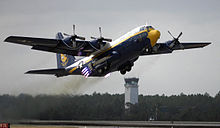
The "Blues" F/A-18 aircraft are former fleet aircraft that are nearly combat-ready. They can be repainted and readied for combat service in just 72 hours.[3] Significant modifications to each aircraft include removal of the aircraft gun and replacement with the tank that contains the paraffin-based smoked oil used in demonstrations, installation of inverted fuel pumps to increase the time aircraft can spend inverted without fuel starvation, and outfitting with the control stick spring system that is used to facilitate more precise aircraft control inputs. The standard demonstration configuration is such that the pilot must overcome 40 pounds of nose-down stick input to maintain level flight. The Blue Angels do not wear G-suits, because the air bladders inside them would repeatedly deflate and inflate. That would interfere with the control stick between a pilot's legs. Instead, Blue Angel pilots tense their stomach muscles and legs to prevent blood from rushing from their heads and rendering them unconscious.[3]
The show narrator flies Blue Angel 7—a two-seat FA-18B—to shows sites. The Blue Angels use this jet for backup, and to give demonstration flights to civilians (usually members of the press). The #4 slot pilot often flies the #7 aircraft in Friday "practice" shows.
The Blue Angels use a United States Marine Corps C-130T Hercules nicknamed "Fat Albert" for logistics, carrying spare parts, equipment, and to carry support personnel between shows. Starting in 1975, "Bert" was used for Jet Assisted Take Off (JATO) and short aerial demonstrations just prior to the main event at selected venues, but the JATO demonstration ended in 2009 due to dwindling supplies of rockets.[4] "Fat Albert Airlines" flies with an all-Marine crew of three officers and five enlisted personnel.
Team members
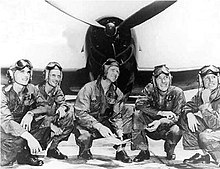
All team members, both officer and enlisted, come from the ranks of regular Navy and United States Marine Corps units. The demonstration pilots and narrator are made up of Navy and USMC Naval Aviators. Pilots typically serve two years, and position assignments are made according to team needs, pilot experience levels, and career considerations for members. The team leader (#1) is the Commanding Officer and is always a Navy Commander, who may be promoted to Captain mid-tour depending on if he has been approved for Captain by the selection board. Pilots of numbers 2-7 are Navy Lieutenants or Lieutenant Commanders. There are usually one or two Marines among this group, ranked Captain or Major. The number 7 pilot narrates for a year, and then typically flies Opposing and then Lead Solo the following two years, respectively. The number 3 pilot moves to the number 4 (slot) position for his second year. Blue Angel #4 serves as the demonstration safety officer, due largely to the perspective he is afforded from the slot position within the formation, as well as his status as a second-year demonstration pilot. There are a number of other officers in the squadron, including a Naval Flight Officer, the USMC C-130 pilots, a Maintenance Officer, an Administrative Officer, and a Flight Surgeon. Enlisted members range from E-4 to E-9, and perform all maintenance, administrative, and support functions. After serving with the "Blues", members return to fleet assignments.
Members of the 2010 season USN Blue Angels Team:
- Flying Blue Angel No.1 Commander Greg McWherter (Commander/Leader)
- Flying Blue Angel No.2 Lieutenant James Tomaszeski (Right Wing)
- Flying Blue Angel No.3 Lieutenant Robert Kurrle Jr. (Left Wing)
- Flying Blue Angel No.4 Major Chris Collins USMC (Slot)
- Flying Blue Angel No.5 Lieutenant Commander Frank Weisser (Lead Solo)
- Flying Blue Angel No.6 Lieutenant Ben Walborn (Opposing Solo)
- Flying Blue Angel No.7 Lieutenant Christian Simonsen (Advance Pilot/Narrator)
- Lieutenant Amy Tomlinson No.8 (Events Coordinator)
- Major Brendan Burks USMC (C-130 Pilot)
- Captain Edward Jorge USMC (C-130 Pilot)
- Captain Benjamin Blanton USMC (C-130 Pilot)
- Lieutenant John Thompson (Maintenance Officer)
- Lieutenant Johannah Valentine (Flight Surgeon)
- Chief Warrant Officer 4 Adolfo P. DeMontalvo (Executive/Administrative Officer)
- Captain Tyson Dunkelberger USMC (Public Affairs Officer)
- Chief Warrant Officer 3 Clive Dixon (Supply Officer)
Training and weekly routine

Annual winter training takes place at NAF El Centro, CA, where new and returning pilots hone skills learned in the fleet. Separation between the formation of aircraft and their maneuver altitude is gradually reduced over the course of about two months in January and February. The team returns to their home base of Pensacola, Florida in March, and continue to practice throughout the show season. A typical week during the season has practices at NAS Pensacola on Tuesday and Wednesday mornings. The team then flies to its show venue for the week on Thursday, conducting "circle and arrival" orientation maneuvers upon arrival. The team flies a "practice" airshow at the show site on Friday. This show is attended by invited guests but is often open to the general public. The main airshows are conducted on Saturdays and Sundays, with the team returning home on Sunday evenings. Mondays are the only routine day off.
History
1940s

On April 24, 1946 Chief of Naval Operations Admiral Chester Nimitz issued a directive ordering the formation of a flight exhibition team to boost Navy morale, demonstrate naval air power, and maintain public interest in naval aviation. However, an underlying mission was to help the Navy generate public and political support for a larger allocation of the shrinking defense budget. In April of that year, Rear Admiral Ralph Davison personally selected Lieutenant Commander Roy Marlin "Butch" Voris, a World War II fighter ace, to assemble and train a flight demonstration team, naming him Officer-in-Charge and Flight Leader. Voris selected three fellow instructors to join him (Lt. Maurice "Wick" Wickendoll, Lt. Mel Cassidy, and Lt. Cmdr. Lloyd Barnard, veterans of the War in the Pacific), and they spent countless hours developing the show. The group perfected its initial maneuvers in secret over the Florida Everglades so that, in Voris' words, "...if anything happened, just the alligators would know." The team's first demonstration before Navy officials took place on May 10, 1946 and was met with enthusiastic approval.
On June 15 Voris led a trio of Grumman F6F-5 Hellcats, specially modified to reduce weight and painted sea blue with gold leaf trim, through their inaugural 15-minute-long performance at their Florida home base, Naval Air Station Jacksonville.[1] The team employed a an SNJ Texan, painted and configured to simulate a Japanese Zero, to simulate aerial combat. This aircraft was later painted yellow and dubbed the "Beetle Bomb".
The team thrilled spectators with low-flying maneuvers performed in tight formations, and (according to Voris) by "...keeping something in front of the crowds at all times. My objective was to beat the Army Air Corps. If we did that, we'd get all the other side issues. I felt that if we weren't the best, it would be my naval career." The Blue Angels' first public demonstration also netted the team its first trophy, which sits on display at the team's current home at NAS Pensacola.

The team soon became known worldwide for its spectacular aerobatic maneuvers. On August 25, 1946 the squadron upgraded their aircraft to the F8F-1 Bearcat. In 1949, the team acquired a Douglas R4D Sky Train for logistics to and from show sites. The team's SNJ was also replaced by a F8F-1 "Bearcat", painted yellow for the air combat routine. The Blues transitioned to the straight-wing Grumman F9F-2 Panther on July 13, 1949, wherein the F8F-1 "Beetle Bomb" was relegated to solo aerobatics before the main show, until it crashed on takeoff at a training show in Pensacola in 1950.
Team headquarters shifted from NAS Corpus Christi, Texas, to NAAS Whiting Field, Florida, in the fall of 1949, announced 14 July 1949. [5]
1950s
The "Blues" continued to perform nationwide until the start of the Korean War in 1950, when (due to a shortage of pilots, and no planes were available) the team was disbanded and its members were ordered to combat duty. Once aboard the aircraft carrier USS Princeton the group formed the core of VF-191 (Satan's Kittens).
The Blue Angels were officially recommissioned on October 25, 1951, and reported to NAS Corpus Christi, Texas. Lt. Cdr. Voris was again tasked with assembling the team (he was the first of only two commanding officers to lead them twice). In 1953 the team traded its Sky Train for a Curtiss R5C Commando.
The Blues remained in Corpus Christi until the winter of 1954, when they relocated to their present home at NAS Pensacola. It was here they progressed to the swept-wing Grumman F9F-8 Cougar.
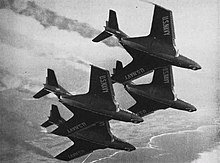
The first Marine Corps pilot, Capt Chuck Hiett, joined the team and they relocated to their current home of NAS Pensacola in the winter of 1954. In August 1954, "Blues" leader LCDR Ray Hawkins becomes the first naval aviator to survive an ejection at supersonic speeds when his F9F-6 became uncontrollable on a cross-country flight.
In Sept 1956, the team added a sixth aircraft to the flight demonstration in the Opposing Solo position, and gave its first performance outside the United States at the International Air Exposition in Toronto, Canada. It also upgraded its logistics aircraft to the Douglas R5D Skymaster.

In January 1957, the team left its winter training facility at Naval Air Facility El Centro, California for a ten year period. For the next ten years, the team would winter at NAS Key West, Florida. For the 1957 show season, the Blue Angels transitioned to the supersonic Grumman F11F-1 Tiger, first flying the short-nosed, and then the long-nosed versions. The first Six-Plane Delta Maneuvers were added in the 1958 season.
1960s
In July 1964, the Blue Angels participated in the Aeronaves de Mexico Anniversary Air Show over Mexico City, Mexico, before an estimated crowd of 1.5 million people.
In 1965, the Blue Angels conducted a Caribbean island tour, flying at five sites. Later that year, they embarked on a European tour to a dozen sites, including the Paris Air Show, where they were the only team to receive a standing ovation.
The Blues toured Europe again in 1967 touring six sites. In 1968 Skymaster transport aircraft was replaced with a C-121J Constellation. The Blues transitioned to the two-seat McDonnell Douglas F-4J Phantom II in 1969, nearly always keeping the back seat empty for flight demonstrations. The Phantom was the only plane to be flown by both the "Blues" and the United States Air Force Thunderbirds. That year they also upgraded to the 'Lockheed C-121 Super Constellation for logistics.
1970s

The Blues received their first U.S Marine Corps Lockheed KC-130F Hercules (Bureau Number 150690) in 1970. An all-Marine crew manned it. That year, they went on their first South American tour. In 1971, the team conducted its first Far East Tour, performing at a dozen locations in Korea, Japan, Taiwan, Guam, and the Philippines. In 1972, the Blue Angels were awarded the Navy's Meritorious Unit Commendation for the two-year period from March 1, 1970 - December 31, 1971. Another European tour followed in 1973, including air shows in Tehran, Iran, England, France, Spain, Turkey, Greece, and Italy.
In December 1974 the Navy Flight Demonstration Team downsized to the subsonic McDonnell Douglas A-4F Skyhawk II and was reorganized into the Navy Flight Demonstration Squadron. This reorganization permitted the establishment of a commanding officer (the flight leader), added support officers, and further redefined the squadron's mission emphasizing the support of recruiting efforts. Commander Tony Less was the squadron's first official commanding officer.

1980s
On November 8, 1986 the Blue Angels completed their 40th anniversary year during ceremonies unveiling their present aircraft, the McDonnell Douglas F/A-18 Hornet, the first multi-role fighter/attack aircraft. The power and aerodynamics of the Hornet allows them to perform a slow, high angle of attack "tail sitting" maneuver, and to fly a "dirty" (landing gear down) formation loop, the last of which is not duplicated by the Thunderbirds.
Also in 1986, LCDR Donnie Cochran, joined the Blue Angels as the first African-American Naval Aviator to be selected. He would return to lead the team in 1993.
1990s
In 1992 the Blue Angels deployed for a month-long European tour, their first in 19 years, conducting shows in Sweden, Finland, Russia (the first foreign flight demonstration team to perform there), Romania, Bulgaria, Italy, the United Kingdom and Spain. In 1998, CDR Patrick Driscoll made the first "Blue Jet" landing on a "haze gray and underway" aircraft carrier, USS Harry S. Truman (CVN-75).
2000s
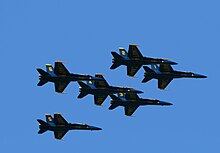
In 2006, the Blue Angels marked their 60th year of performing.[6] On October 30, 2008 a spokesman for the team announced that the team would complete its last three performances of the year with five jets instead of six. The change was because one pilot and another officer in the organization had been removed from duty for engaging in an "inappropriate relationship". The Navy stated that one of the individuals was a man and the other a woman, one a Marine and the other from the Navy, and that Rear Admiral Mark Guadagnini, chief of Naval air training, was reviewing the situation.[7] At the next performance at Lackland Air Force Base following the announcement the #4 or slot pilot, was absent from the formation. A spokesman for the team would not confirm the identity of the pilot removed from the team.[8] On November 6, 2008 both officers were found guilty at an admiral's mast on unspecified charges but the resulting punishment was not disclosed.[9]
In November, it was announced that the Fat Albert demo would perform its final JATO demonstration at their Pensacola Homecoming show, spending their 8 remaining JATO bottles. This demonstration not only was the final JATO performance of the squadron, but also the final JATO profile of the entire US Marine Corps. "[2]"
Aircraft timeline
The "Blues" have flown nine different demonstration aircraft and five support aircraft models.
Demonstration aircraft
- Grumman F6F-5 Hellcat - June-August 1946
- Grumman F8F-1 Bearcat - August 1946-1949
- Grumman F9F-2 Panther - 1949-June 1950 (first jet);
- Grumman F9F-5 Panther - 1951-Winter 1954/55
- Grumman F9F-8 Cougar - Winter 1954/55-mid-season 1957 (swept-wing)
- Grumman F11F-1 Tiger - mid-season 1957-1969 (first supersonic jet)
- McDonnell F-4J Phantom II - 1969-December 1974
- Douglas A-4F Skyhawk - December 1974-November 1986
- McDonnell Douglas (now Boeing) F/A-18A/B Hornet - November 1986-Present. They are currently transitioning to the F/A-18C/D.[citation needed]
Support
- Douglas R4D Sky Train - 1949-1955
- Curtiss R5C Commando - 1953
- Douglas R5D Skymaster - 1956-1968
- Lockheed C-121 Super Constellation - 1969-1973
- Lockheed C-130 Hercules - 1970-Present
Miscellaneous aircraft
Show routine


- Fat Albert (C-130) – high performance takeoff (Low Transition)
- Fat Albert - Parade Pass (Photo Pass. The plane banks around the front of the crowd)
- Fat Albert - Flat Pass
- Fat Albert - Head on Pass
- Fat Albert - Short-Field Assault Landing
- FA-18 Engine Start-Up and Taxi Out
- Diamond Take-off (Either a low transition with turn, loop on takeoff, a half-Cuban 8 takeoff, or a Half Squirrel Cage)
- Solos Take-off (Blue Angel #5: Dirty Roll on Take-Off; Blue Angel #6: Low Transition pitch up)
- Diamond 360: Aircraft 1, 2, 3 and 4 are in their signature 18" wingtip-to-canopy diamond formation.
- Opposing Knife-Edge Pass
- Diamond Roll: The whole diamond formation rolls as a single entity.
- Opposing Inverted to Inverted Rolls
- Diamond Aileron Roll: All 4 diamond jets perform simultaneous aileron rolls.
- Fortus: Solos flying in carrier landing configuration with #5 inverted, establishing a "mirror image" effect.
- Diamond Dirty Loop: The diamond flies a loop with all 4 jets in the carrier landing configuration.
- Minimum Radius Turn (Highest G maneuver. #5 flies a "horizontal loop" pulling 7 Gs to maintain a tight radius)
- Double Farvel: Diamond formation flat pass with aircraft 1 and 4 inverted.
- Opposing Minimum Radius Turn
- Echelon Parade
- Opposing Horizontal Rolls
- Left Echelon Roll: The roll is made into the Echelon, which is somewhat difficult for the outside aircraft.
- Sneak Pass: the fastest speed of the show is about 700 mph (just under Mach 1 at sea level) Video
- Line-Abreast Loop – the most difficult formation maneuver to do well. #5 joins the diamond as the 5 jets fly a loop in a straight line
- Opposing Four-Point Hesitation Roll
- Vertical Break
- Opposing Pitch Up
- Barrel Roll Break
- Section High-Alpha Pass: (tail sitting), the show's slowest maneuver[10]
- Low Break Cross
- Inverted Tuck Over Roll
- Tuck Under Break
- Delta Roll
- Fleur de Lis
- Solos Pass to Rejoin, Diamond flies a loop
- Loop Break Cross (Delta Break): After the break the aircraft separate in six different directions, perform half Cuban eights then cross in the center of the performance area.
- Delta Breakout
- Delta Pitch Up Break to Land
Source: Videos of these maneuvers
Accidents
During its history, 26 Blue Angels pilots have been killed in air show or training accidents.[11] Through the 2006 season there have been 262 pilots in the squad's history,[12] giving the job a 10% fatality rate.
- 1946 - September: Lt. "Robby" Robinson was killed during a performance when a wingtip broke off his Bearcat, sending him into an unrecoverable spin.
- 1952 - Two Panthers collided during a demonstration in Corpus Christi, Texas and one pilot was killed. The team resumed performances two weeks later.
- October 14, 1958 - Cmdr. Robert Nicholls Glasgow died during an orientation flight just days after reporting for duty as the new Blue Angels leader.[13]
- 15 March 1964 - Lt. George L. Neale, 29, was killed during an attempted emergency landing at Apalach Airport near Apalachicola, Florida. Lt. Neale's F-11A Tiger had experienced mechanical difficulties during a flight from West Palm Beach, Florida to NAS Pensacola, causing him to attempt the emergency landing. Failing to reach the airport, he ejected from the aircraft on final approach, but his parachute did not have sufficient time to fully deploy.[14]
- September 2, 1966 - Lt. Cmdr. Dick Oliver crashed his Tiger and was killed at the Canadian International Air Show in Toronto.
- February 1, 1967 - Lt Frank Gallagher was killed when his Tiger stalled during a practice Half Cuban 8 maneuver and spun into the ground.
- February 18, 1967 - Capt. Ronald Thompson was killed when his Tiger struck the ground during a practice formation loop.
- January 14, 1968 - Opposing solo Lt. Bill Worley was killed when his Tiger crashed during a practice double immelman.
- June 4, 1971 - CDR Harley Hall safely ejected after his Phantom caught fire and crashed during practice over Narragansett Bay near the ex-NAS Quonset Point in Rhode Island.
- January 8, 1972 - Lt. Larry Watters was killed when his Skyhawk struck the ground while practicing inverted flight.
- March 8, 1973 - Capt. John Fogg, Lt. Marlin Wiita and LCDR Don Bentley survived a multi-aircraft crash in mid-air during practice over the Superstition Mountains in California.
- July 26, 1973 - 2 pilots and a crew chief were killed in a mid-air collision between 2 Phantoms over Lakehurst, NJ during an arrival practice. Team Leader LCDR Skip Umstead, Capt. Mike Murphy and ADJ1 Ron Thomas perished. The rest of the season was cancelled after this incident.
- February 22, 1977 - Opposing solo Lt. Nile Kraft was killed when his Skyhawk struck the ground during practice.
- November 8, 1978 - One of the solo Skyhawks struck the ground after low roll during arrival maneuvers at NAS Miramar. Navy Lieutenant Michael Curtain was killed.
- May 31, 1980 - Lead Solo Lt. Jim Ross was unhurt when his Skyhawk suffered a fuel line fire during a show at NS Roosevelt Roads, Puerto Rico. LT Ross stayed with and landed the plane which left the end of the runway and taxied into the woods after a total hydraulic failure upon landing.
- February 22, 1982 - Lt. Cmdr Stu Powrie, Lead Solo was killed when his Skyhawk struck the ground during winter training at Naval Air Facility El Centro, California just after a dirty loop.
- July 13, 1985 - Lead and Opposing Solo Skyhawks collided during a show at Niagara Falls, killing opposing solo Lt. Cmdr. Mike Gershon. Lt. Andy Caputi ejected and parachuted to safety.[15]
- February 12, 1987 - Lead solo Lt. Dave Anderson ejected from his Hornet after a dual engine flameout during practice near El Centro, CA.
- January 23, 1990 - Two Blue Angel Hornets suffered a mid-air collision during a practice at El Centro. Marine Corps Maj. Charles Moseley ejected safely. Cmdr. Pat Moneymaker landed his airplane, but it never flew again.[16]
- October 28, 1999 - Lt. Cmdr. Kieron O'Connor, flying in the front seat of a two-seat Hornet, and recently selected demonstration pilot Lt. Kevin Colling (in the back seat) struck the ground during circle and arrival maneuvers in Valdosta, Georgia. Neither pilot survived.[17]
- December 2, 2004 - Lt. Ted Steelman ejected from his F/A-18 approximately one mile off Perdido Key after his aircraft struck the water, suffering catastrophic engine and structural damage. He suffered minor injuries.[18]
- April 21, 2007 - Lt. Cmdr. Kevin J. Davis crashed his Hornet near the end of the Marine Corps Air Station Beaufort airshow in Beaufort, South Carolina[19] and was killed.[20][21] (See 2007 Blue Angels South Carolina crash).
Other incidents involving former Blue Angels
- 1951 - LCDR Johnny Magda, while flying in Korea, was the first former Blue Angel killed in combat.
- January 27, 1973 - CDR Harley Hall (1970 team leader) was shot down flying an F-4J over Vietnam, and was officially listed as Missing In Action.
In the media

- The Blue Angels was a dramatic television series, starring Dennis Cross and Don Gordon, inspired by the team's exploits and filmed with the cooperation of the Navy. It aired in syndication from September 26, 1960 to July 3, 1961.[22]
- The Blue Angels were the subject of "Flying Blue Angels," a pop song recorded by George, Johnny and the Pilots (Coed Co 555), that debuted on Billboard Magazine's "Bubbling Under the Hot 100" chart on September 11, 1961.
- Threshold: The Blue Angels Experience was a 1975 documentary film, written by Dune author Frank Herbert, featuring the team in practice and performance during their F-4J Phantom period; many of the aerial photography techniques pioneered in Threshold were later used in the film Top Gun.[23]
- In 2005, the Discovery Channel aired a documentary miniseries, Blue Angels: A Year in the Life, focusing on the intricate day-to-day details of that year's training and performance schedule.[24][25]
- The video for the American rock band Van Halen's 1986 release "Dreams" consists of Blue Angels performance footage. The video was originally shot featuring the Blues in the A-4 Skyhawk.
- The Blue Angels appeared on an episode of Tim Allen's television sitcom Home Improvement as themselves.
- The Blue Angels were featured in the I-Max film "Magic of Flight".
- The Blue Angels Creed, written by JO1 Cathy Konn, 1991-1993:
Today is a very special and memorable day in your military career that will remain with you throughout your lifetime. You have survived the ultimate test of your peers and have proven to be completely deserving to wear the crest of the U.S. Navy Blue Angels. The prestige of wearing the Blue Angels uniform carries with it an extraordinary honor — one that reflects not only on you as an individual, but on your teammates and the entire squadron. To the crowds at the air shows and to the public at hospitals and schools nationwide, you are a symbol of the Navy and Marine Corps' finest. You bring pride, hope and a promise for tomorrow's Navy and Marine Corps in the smiles and handshakes of today's youth. Remember today as the day you became a Blue Angel; look around at your teammates and commit this special bond to memory. "Once a Blue Angel, always a Blue Angel," rings true for all those who wear the crest of the U.S. Navy Blue Angels. Welcome to the team.
- In 2009, the MythBusters enlisted the aid of Blue Angels to help test the myth that a sonic boom could shatter glass.
Notable alumni
- Captain Chuck Brady — Astronaut
- Captain Donnie Cochran — first African-American Blue Angels aviator
- Captain Robert L. Rasmussen — Aviation Artist
- Commander Raleigh Rhodes —World War II veteran and third leader of the Blue Angels[26]
- Captain Roy Marlin Voris — First Blue Angel leader
- Admiral Patrick M. Walsh — Left Wingman and Slot Pilot, 1985-1987; Vice Chief of Naval Operations
Air show schedule
A link to the current Blue Angels schedule can be found in the External links section below.
See also
- Blue Angels Alumni Association
- Naval aviation
- United States Marine Corps Aviation
- List of United States Navy aircraft squadrons
References
- ^ a b History of the Blue Angels, Blue Angels official website.
- ^ Campbell, War Paint, p171
- ^ a b Blue Angels Frequently Asked Questions
- ^ McCullough, Amy (2009-11-09). "Abort Launch: Air shows to do without Fat Albert's famed JATO". Marine Corps Times. Gannett Company. p. 6.
{{cite news}}:|access-date=requires|url=(help) - ^ Fort Walton, Florida, "'Blue Angels' To Pensacola - Navy Flight Exhibition Team Is Transferred", Playground News, Thursday 14 July 1949, Volume 4, Number 24, page 2.
- ^ Blue Angels Monumental Moments
- ^ Moon, Troy (2008-10-31). "Blues Angels Pilot, Other Grounded". Pensacola News Journal. Retrieved 2008-11-04.
- ^ Griggs, Travis (2008-11-02). "No. 4 jet missing from Blue Angels". Pensacola News Journal. Retrieved 2008-11-04.
- ^ Scutro, Andrew, "2 Blue Angels found guilty, await punishment", Military Times, November 8, 2008.
- ^ Blue Angels FAQ
- ^ Investigators probe Blue Angels crash, MSNBC, April 22, 2007
- ^ Blue Angels Alumni FAQ, last updated March 17, 2007.
- ^ Blue Angels crash artifacts found 50 years later, Associated Press, March 3, 2009
- ^ Basham, Dusty, "Blue Angel Pilot Killed - Jet Fighter Falls Near Apalachicola", Playground Daily News, Fort Walton Beach, Florida, Monday Morning, 16 March 1964, Volume 18, Number 27, pages 1, 2.
- ^ "Navy Blue Angel Aviators Die in Crash", October 28, 1999, accessed April 23, 2007
- ^ "Pilot Blamed In Blue Angel Crash", Pensacola News Journal, June 13, 1990, archived at The Moneymaker Family Tree, accessed April 23, 2007
- ^ "Blue Angel crash victims identified", CNN, October 28, 1999, accessed April 23, 2007
- ^ "Blue Angels Pilot Ejects Before Plane Crashes", Fox News, December 2, 2004, accessed April 23, 2007
- ^ Pilot killed in S.C. Blue Angel crash"
- ^ U.S. Navy "Blue Angels" jet crashes
- ^ Blue Angels Pilot fascinated by flying
- ^ Blue Angels TV series, 1960
- ^ [1]
- ^ Blue Angels: A Year in the Life
- ^ "Blue Angels: A Year in the Life" (2005)
- ^ "Combat pilot in two wars led Blue Angels". Los Angeles Times. 2007-12-07. Retrieved 2007-12-13.
Further reading
- (2005). "The First Blue Angel." Miramar 50th Air Show Special Commemorative Program 18.
- (2005). "The Blue Angels History." Miramar 50th Air Show Special Commemorative Program 22.
- Blue Angels Timeline (1946–1980) accessed November 10, 2005.
- "First Blue: Monterey resident Butch Voris formed the nation’s most-loved aviation team" article by Brett Wilbur in the April 1, 2004 edition of the Monterey County Weekly — accessed October 16, 2005.
- "Grumman and the Blue Angels" article by William C. Barto at the Grumman Memorial Park official website — accessed October 15, 2005.
- "First Blue: The story of World War II Ace Butch Voris and the Creation of the Blue Angels" by Robert K. Wilcox, Thomas Dunne Books/St.Martins Press, 2004, www.robertkwilcox.com
- http://moneymaker.rootsweb.com/newspapers/clip08.htm
External links
- Blue Angels, official U.S. Navy web site
- First Blue Angel, the story of World War II Ace Butch Voris and the Creation of the Blue Angels
- U.S. Navy Blue Angels Alumni Association official website
- Blue Angels at San Francisco Air Show Pictures
- RTP-TV Aerospace Show on the Blue Angels (online video)
- 2004 Photo of Navy Blue Angels aerobatic team
- Lists all Blue Angels Pilots Killed or Ejected
- The Blue Angels and Friends Network - Blue Angels videos, photos, friends, fans and former pilots of the Blue Angels
- Flying Full Circle: A 10-minute short film documenting the experience of a VIP ride with the Blue Angels
- 1968 Blue Angel #5 F11F-1 Tiger on display at Combat Air Museum

